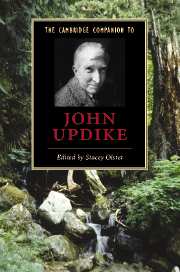Book contents
- Frontmatter
- Introduction: “A sort of helplessly 50’s guy”
- Part I Early influences and recurrent concerns
- 1 Updike, middles, and the spell of “subjective geography”
- 2 “Nakedness” or realism in Updike’s early short stories
- 3 Updike, religion, and the novel of moral debate
- Part II Controversy and difference
- Part III American chronicles
- Conclusion: U(pdike) & P(ostmodernism)
- Select bibliography
- Index
2 - “Nakedness” or realism in Updike’s early short stories
from Part I - Early influences and recurrent concerns
Published online by Cambridge University Press: 28 August 2006
- Frontmatter
- Introduction: “A sort of helplessly 50’s guy”
- Part I Early influences and recurrent concerns
- 1 Updike, middles, and the spell of “subjective geography”
- 2 “Nakedness” or realism in Updike’s early short stories
- 3 Updike, religion, and the novel of moral debate
- Part II Controversy and difference
- Part III American chronicles
- Conclusion: U(pdike) & P(ostmodernism)
- Select bibliography
- Index
Summary
From the beginning of his career, the kind of realistic writing that Updike practices in his short stories has been devoted to what one of his narrators somewhat ruefully calls “quotidian fluff”: an asparagus patch in “Flight” (1959), a listing of supermarket items in “A & P” (1961), the detailed pattern of a bird's plumage in “Pigeon Feathers” (1961). To a certain extent, this preference can be attributed to Updike's apprenticeship at the New Yorker, “a loving respect for facticity - for the exactly what of matters” comprising the “shared heritage” he found common to all those who worked at the magazine under Harold Ross (Hugging, 848). To a larger extent, it reflects the influence of two acknowledged predecessors. One, William Dean Howells, Updike praises for “bringing dullness and mixedness out of the rain of actuality into the house of fiction” (Odd, 170). Skirting, on the one hand, the melodramatic plots and morally balanced endings that marked the classic European novel and, on the other hand, the subjects peripheral to ordinary experience (such as whaling ships) that formed the basis of the classic American novel, Howells, with his “fidelity to the mild, middling truth of average American life” (183), provided a model of realism that pointed to “the triumph of American life,” the fact, according to Updike, “that so much of it should be middling” (189). Walt Whitman, in contrast, Updike commends for granting the minutiae of that model metaphysical dimensions. Quoting, in a talk on Whitman's “egotheism,” the transcendentalist poet's assertion that “the true use for the imaginative faculty of modern times is to give ultimate vivification to facts, to science, and to common lives, endowing them with glows and glories and final illustriousness which belong to every real thing, and to real things only” (Hugging, 117), Updike delineates the democratizing ramifications that this credo of such an unlikely prophet of realistic writing augured: real things - an old milk carton as much as a rose, a trolley car as much as a tree - can be “assigned the sacred status that in former times was granted to mysteries” (Picked-Up, 518; Hugging, 117).
- Type
- Chapter
- Information
- The Cambridge Companion to John Updike , pp. 29 - 42Publisher: Cambridge University PressPrint publication year: 2006
- 2
- Cited by

